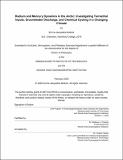Radium and Mercury Dynamics in the Arctic: Investigating Terrestrial Inputs, Groundwater Discharge, and Chemical Cycling in a Changing Climate
Author(s)
Bullock, Emma Jacqueline
DownloadThesis PDF (6.482Mb)
Advisor
Charette, Matthew A.
Terms of use
Metadata
Show full item recordAbstract
The Arctic Ocean is distinctive due to its extreme seasonal variations in temperature and significant terrestrial inputs, including freshwater, carbon, nutrients, and toxins. Of particular concern is mercury (Hg) in its neurotoxic form, methylmercury (MeHg), which is already beginning to adversely affect Arctic human populations and wildlife. However, the region’s harsh conditions and remoteness have made conducting seasonal chemical and hydrological studies challenging. Tracers of boundary inputs, such as the radium (Ra) isotope quartet, offer potential for tracking and quantifying riverine and submarine groundwater discharge (SGD) of species like Hg into the Arctic Ocean. This thesis employs seasonal data and laboratory experiments to investigate the factors influencing terrestrial Ra inputs to the Arctic Ocean, quantifies SGD and associated Hg inputs to an Arctic coastal lagoon, and elucidates the chemical and geological factors influencing Hg cycling in Arctic groundwater.
Using historical and unpublished datasets combined with new laboratory investigations, differences in inputs of riverine Ra isotopes between the North American and Eurasian land masses were identified. The findings revealed higher Ra fluxes from the North American continent, attributed to greater sediment loads and lower organic matter in rivers compared to those on the Eurasian land mass. Subsequently, Ra data from five extensive field campaigns to Simpson Lagoon, Alaska, provided insights into Ra cycling on a more localized scale. These campaigns offered the first seasonal perspective on supra-permafrost SGD along an Arctic coastline, suggesting that SGD fluxes may rival those of rivers along the Beaufort Sea coast. Concurrently collected Hg groundwater concentrations allowed for the development of the first estimates of Hg fluxes from groundwater to the Arctic Ocean. If these estimates hold true along the rest of the Pan-Arctic coastline, they could significantly alter our understanding of microbial MeHg uptake in the Arctic Ocean. Finally, sediment cores from Simpson Lagoon and two other locations along the Beaufort Sea coast were used to examine how changing groundwater conditions, such as changing salinity, temperature, and redox conditions, influence Hg cycling. These experiments, alongside findings from Simpson Lagoon groundwater, indicate that Hg cycling in recently thawed permafrost sediments involves a complex interplay between organic material, metal oxides, and sulfide species, with groundwater conditions and soil carbon content playing crucial roles in Hg mobilization.
Date issued
2025-02Department
Massachusetts Institute of Technology. Department of Earth, Atmospheric, and Planetary SciencesPublisher
Massachusetts Institute of Technology